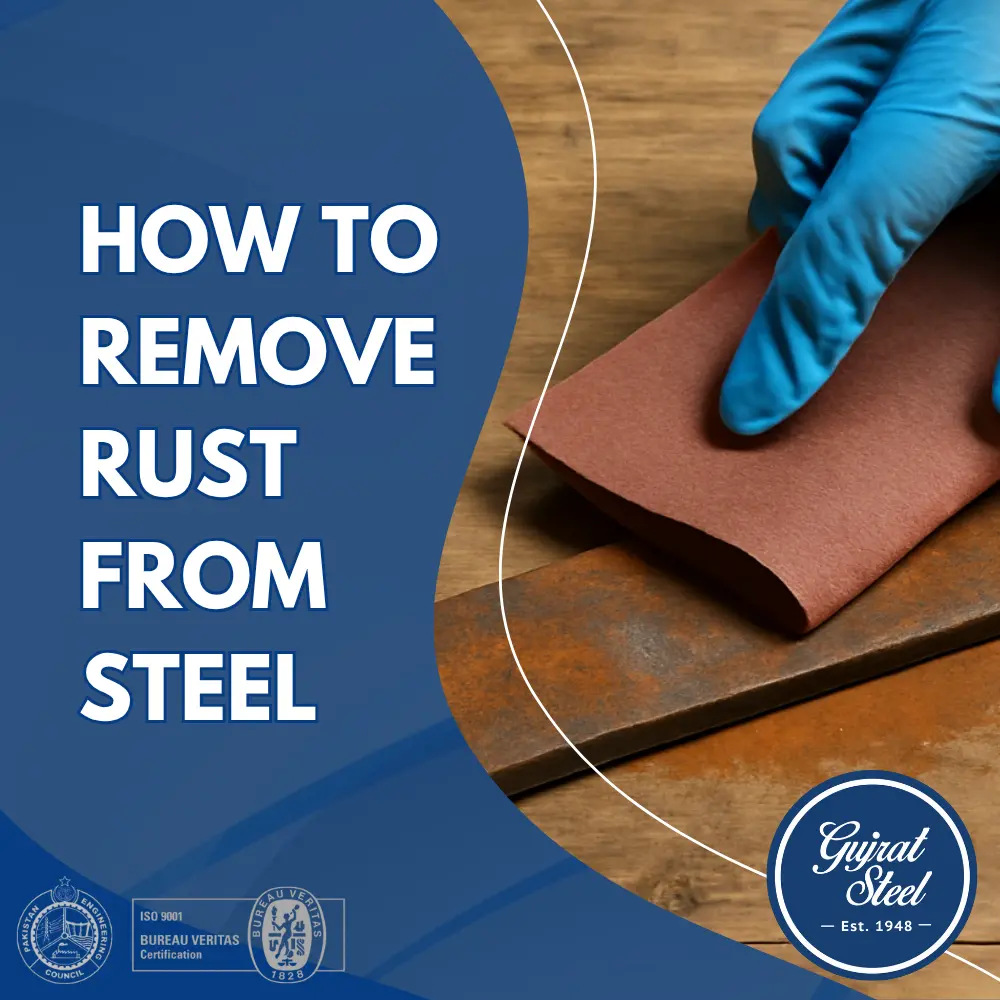This guide details seven effective ways to remove rust from steel, including using vinegar, baking soda, and power tools, with essential safety and surface protection tips.
Key Takeaways
- Safety First: Always wear gloves and eye protection.
- Clean Before Treating: Remove dirt and grease for best results.
- Household Items Work: Vinegar, baking soda, and lemon/salt are great for light rust.
- Mechanical is Fastest: Sandpaper and power tools are best for heavy rust but require more effort.
- Chemicals are Powerful: Commercial rust removers dissolve rust effectively but require caution.
- Drying is Crucial: Dry the steel immediately after treatment to prevent flash rust.
- Protection is Mandatory: Always apply oil, paint, or a sealant to the clean metal to stop rust from returning.
Removing rust from steel is a common but crucial task to restore tools, equipment, and other items. The method you choose will depend on the severity of the rust and the size of the object.
Here are 7 effective ways to remove rust from steel, with detailed step-by-step instructions for each.
Table of Contents
Before You Start: Three Crucial Steps
- Safety First: No matter the method, always wear safety goggles to protect your eyes from debris and splashes, and gloves (rubber or chemical-resistant) to protect your hands. For methods involving dust or fumes, wear a dust mask or respirator.
- Prepare the Surface: Before any rust removal, clean the steel item with a degreaser or soapy water to remove any oil, dirt, or grease. This allows the rust removal agent to work directly on the rust. Dry it thoroughly.
- Test in a Small Area: Always test your chosen method on a small, inconspicuous spot first to ensure it doesn’t damage the underlying metal.
Method 1: The White Vinegar Soak (Mild to Moderate Rust)

Vinegar contains acetic acid, which is excellent for dissolving rust. This method is cheap, effective, and best for items you can submerge.
You Will Need:
- White vinegar
- A container large enough to submerge the item
- A stiff bristle brush or steel wool
- Clean cloths
Step-by-Step Instructions:
- Submerge: Place the rusty steel object into the container and pour in enough white vinegar to completely cover it.
- Soak: Let the item soak for at least 30 minutes for light rust, or up to 24 hours for heavy rust. You will see the rust begin to loosen and flake off.
- Scrub: Remove the item from the vinegar. Use a stiff brush, steel wool, or a crumpled ball of aluminum foil to scrub away the loosened rust. The rust should come off much more easily now.
- Rinse and Dry: Thoroughly rinse the item with clean water to remove all vinegar and rust residue. Immediately and completely dry the item with a cloth or a heat gun to prevent new rust from forming instantly.
- Protect: Apply a protective coating (see “After You Finish” section below).
Method 2: The Baking Soda Paste (Light Rust)

This method creates a gentle abrasive paste that is good for items that can’t be soaked or have delicate surrounding areas.
You Will Need:
- Baking soda
- Water
- A bowl
- A toothbrush or scrub pad
Step-by-Step Instructions:
- Mix the Paste: In a bowl, mix baking soda with a small amount of water until it forms a thick paste, similar in consistency to toothpaste.
- Apply: Spread the paste generously over the rusted areas of the steel. Ensure all rust is covered.
- Wait: Let the paste sit on the rust for at least an hour. It will help loosen the rust.
- Scrub: Use a toothbrush, scrub pad, or steel wool to scrub the area. The baking soda acts as a mild abrasive to lift the rust.
- Rinse, Dry, and Protect: Rinse the object thoroughly, dry it completely, and apply a protective coating.
Method 3: Lemon and Salt (Light Rust Spots)
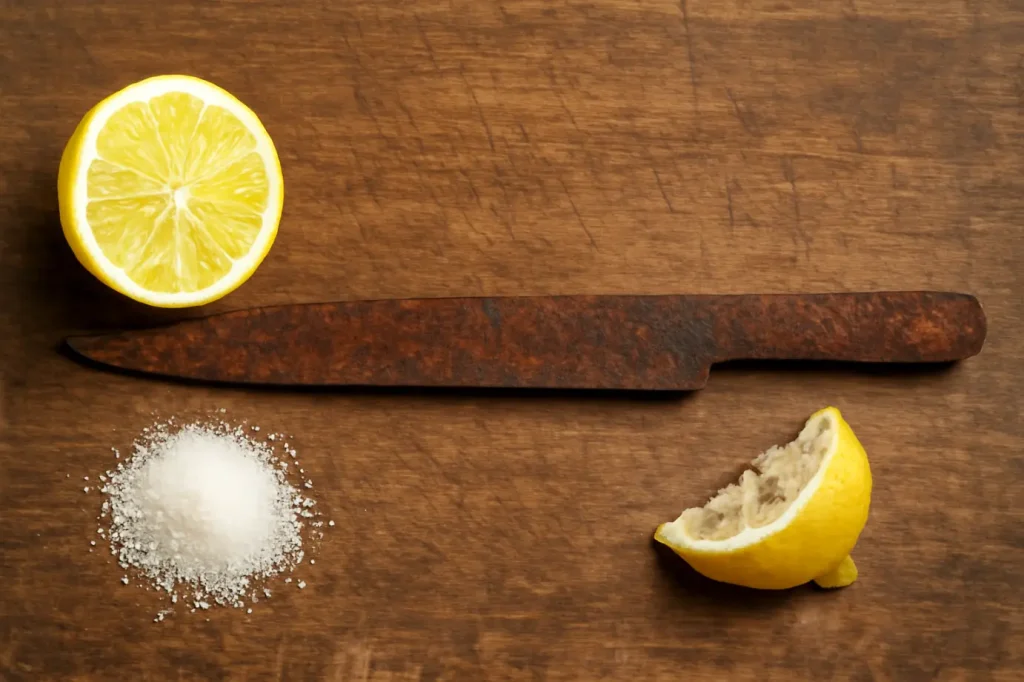
The citric acid from the lemon dissolves rust, and the salt acts as a gentle abrasive. This is great for kitchen knives or small spots.
You Will Need:
- A lemon or lime
- Coarse salt
- A scrub brush or steel wool
Step-by-Step Instructions:
- Salt the Area: Sprinkle a generous layer of coarse salt directly onto the rusted surface.
- Add Acid: Squeeze the juice from a lemon or lime over the salt. Let the mixture sit for 1-2 hours.
- Scrub: Use the leftover lemon rind to scrub the mixture into the rust. The rind is tough enough to scrub without scratching the metal excessively. For tougher rust, use a wire brush.
- Rinse, Dry, and Protect: Rinse thoroughly, dry immediately, and apply a protective finish.
Method 4: Manual Abrasion (All Rust Levels)
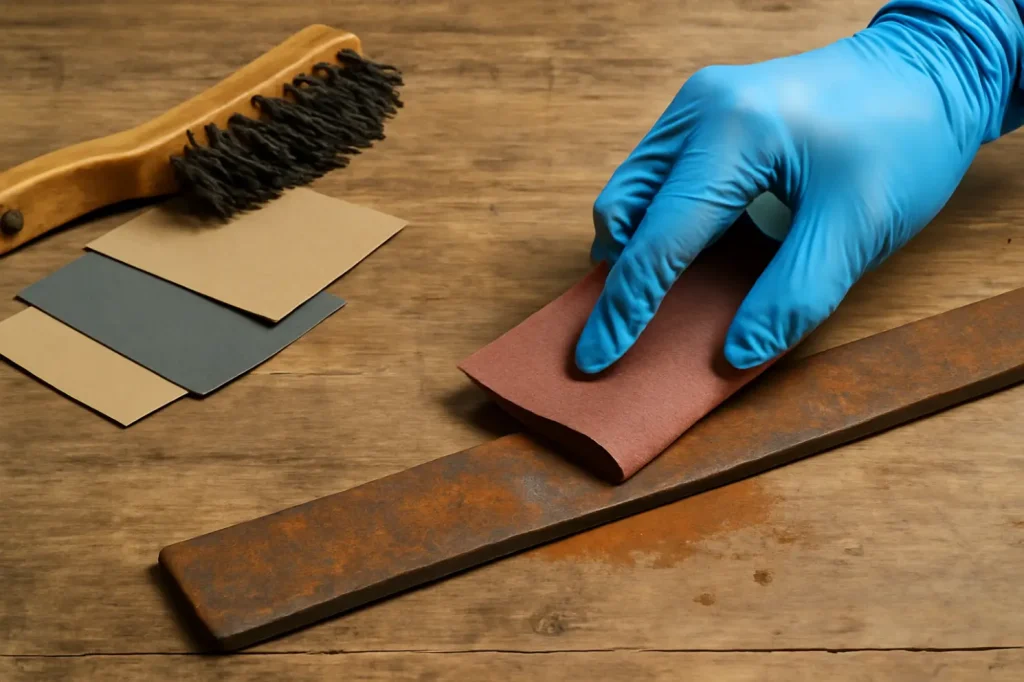
This is the most direct method: physically grinding or scraping the rust off.
You Will Need:
- Sandpaper (in various grits, from coarse ~80 to fine ~400)
- A wire brush
- Steel wool (#0000 for finishing)
Step-by-Step Instructions:
- Start Coarse: Begin with a stiff wire brush to knock off any large, flaky pieces of rust.
- Sand Away Rust: Switch to coarse-grit sandpaper (~80 grit) to sand down the remaining rust. Apply firm, even pressure.
- Smooth the Surface: Once the rust is gone, you will likely have a rough surface. Move to progressively finer grits of sandpaper (e.g., 120, 220, then 400) to smooth out the scratches left by the coarser grit.
- Final Polish: For a very smooth finish, you can use #0000 (super-fine) steel wool as a final polish.
- Wipe, Dry, and Protect: Wipe all dust away with a clean cloth, ensure the item is dry, and apply a protective coating.
Method 5: Power Tools (Heavy Rust & Large Areas)
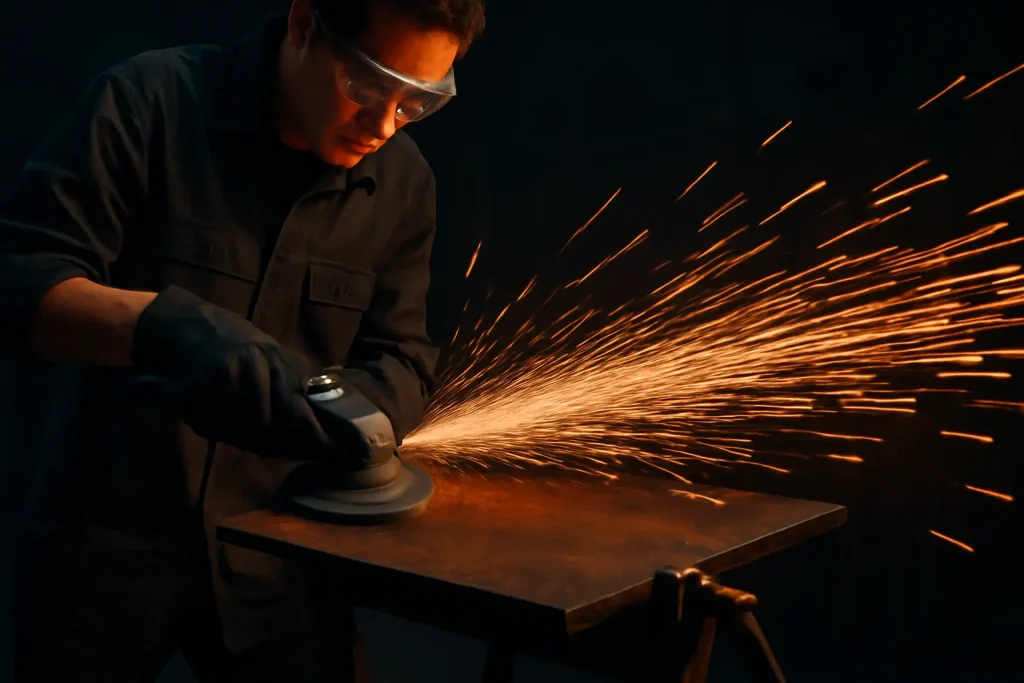
For serious rust jobs, power tools save a massive amount of time and effort. Safety is paramount here.
You Will Need:
- An angle grinder, orbital sander, or drill
- Attachments: Wire wheel, flap disc, or sanding disc
- Sturdy clamps to secure the workpiece
Step-by-Step Instructions:
- Secure the Item: Clamp the steel object firmly to a workbench so it cannot move while you work.
- Attack the Rust: Attach a wire wheel or a coarse flap disc (~60-80 grit) to your angle grinder or drill. Wearing your PPE, turn on the tool and apply it to the rusted surface with steady, even passes. Let the tool do the work; don’t press too hard.
- Smooth the Finish: Once the heavy rust is gone, switch to a finer grit flap disc or sanding pad to smooth out the surface and blend the area into the surrounding metal.
- Wipe, Dry, and Protect: Thoroughly wipe away all metal dust, ensure the surface is clean and dry, and immediately apply a protective coating.
Method 6: Commercial Rust Removers (Moderate to Heavy Rust)
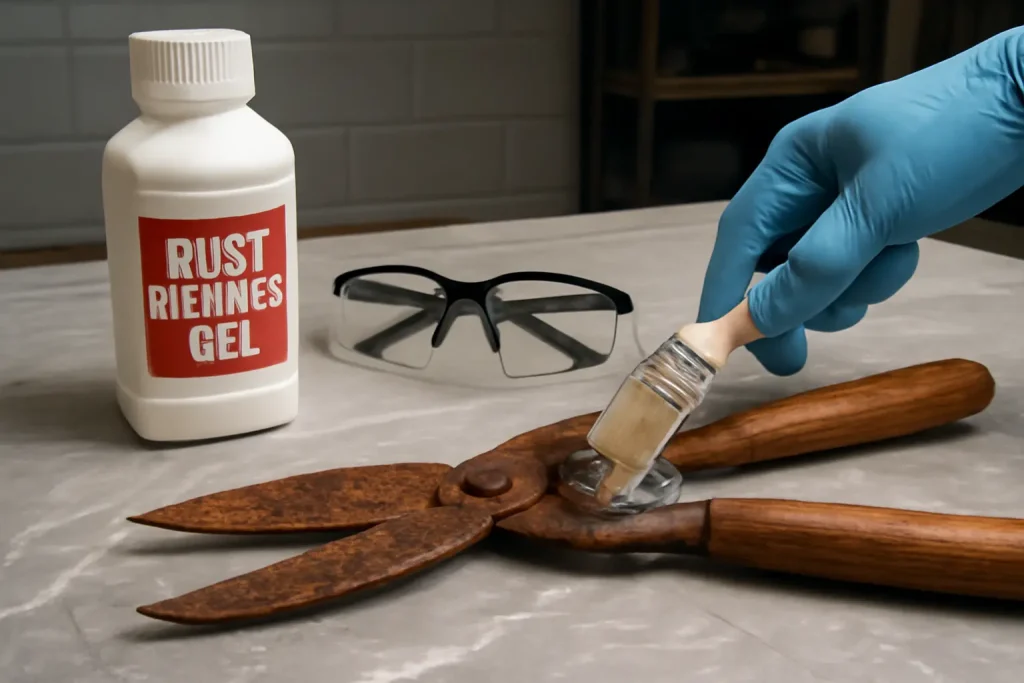
These products use chemicals like phosphoric or oxalic acid to dissolve rust very effectively. Always read and follow the manufacturer’s instructions carefully.
You Will Need:
- A commercial rust remover gel or liquid (e.g., Rust-Oleum Rust Dissolver, Evapo-Rust)
- Chemical-resistant gloves and goggles
- A disposable paintbrush
Step-by-Step Instructions:
- Work in a Ventilated Area: Ensure you are outdoors or in a very well-ventilated space.
- Apply the Product: Depending on the product, you will either brush on a gel or submerge the item in a liquid bath.
- Wait: Follow the product’s instructions for how long to let it work. This can range from 30 minutes to several hours. The rust will often turn black or change color as it is dissolved.
- Scrub and Rinse: After the waiting period, scrub the area with a brush and rinse thoroughly with water as directed by the product label. Some products require neutralization with a baking soda solution.
- Dry and Protect: Dry the steel completely and apply a protective finish.
Method 7: The Citric Acid Soak (A Stronger Food-Safe Option)

Citric acid is stronger than vinegar and is available as a powder. It’s very effective and still relatively safe.
You Will Need:
- Citric acid powder (sold in canning or baking aisles)
- Hot water
- A plastic container
Step-by-Step Instructions:
- Mix the Solution: Fill a container with hot water and add 2-3 tablespoons of citric acid powder per liter of water. Stir until it dissolves.
- Submerge: Place the rusty item in the solution. The hot water will speed up the chemical reaction.
- Soak: You should see bubbling as the acid works on the rust. This method is often faster than vinegar; check after a few hours. For heavy rust, let it soak overnight.
- Scrub, Rinse, Dry, and Protect: As with the other methods, remove the item, scrub off any remaining rust, rinse with clean water, dry immediately, and apply a protective coating.
After You Finish: The Most Important Step
Once you have bare, clean steel, it is extremely vulnerable to “flash rust,” which can form in minutes. You must protect the surface.
- For Tools: Wipe on a thin layer of machine oil, mineral oil, or a dedicated rust-prevention product like WD-40.
- For Outdoor Items: Apply a coat of metal primer followed by a high-quality metal paint.
- For Other Surfaces: Use clear coats, wax, or other sealants appropriate for the item’s use.



